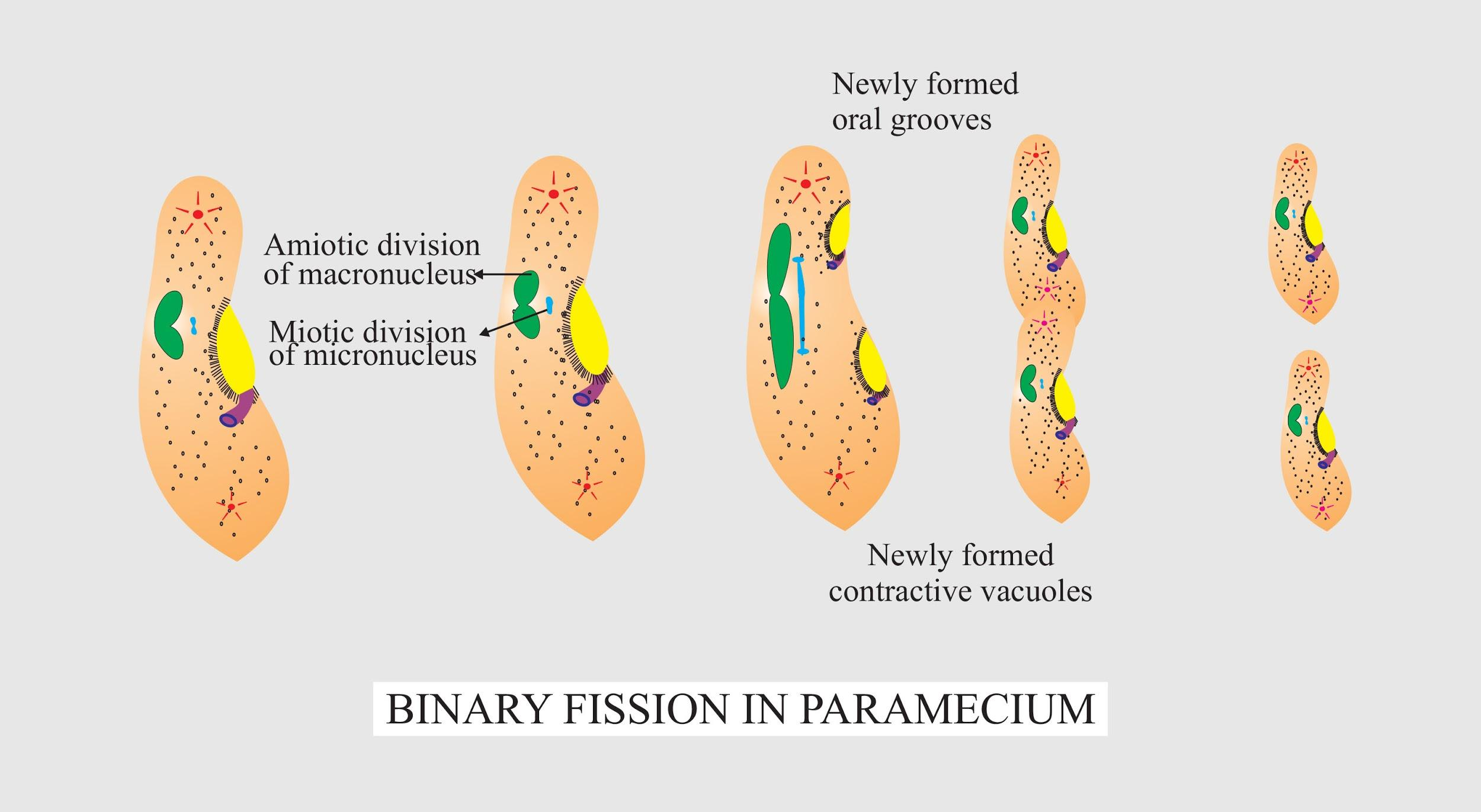
Answer
445.5k+ views
Hint: Paramecium has a special type of reproductive cycle due to its dual nuclear apparatus. They reproduce asexually and induce autogamy or conjugation in certain cases. Their germline nucleus undergoes mitosis during the reproduction phase.
Complete answer:
The asexual reproductive process seen in Paramecium is binary fission.
Paramecium contains a dual nuclear Apparatus like any other ciliates and it consists of polyploid macronucleus and one or more diploid micronuclei. The micronucleus is the germline nucleus and contains genetic material whereas the macronucleus controls non-reproductive cell functions. During binary fission in Paramecium, the macronucleus splits by amitosis whereas the micronuclei undergo mitosis. After that, the cell divides transversally and the new offsprings obtain a copy of both macro and micronucleus.
Additional Information:
We know, in binary fission the mother cell is divided into two identical daughter cells, but in the case of multiple fission instead of 2, many daughter cells are produced from the mother cell. This happens because the nucleus undergoes repeated divisions to produce a large number of nuclei and each of them along with a little bit of cytoplasm forms a membrane around it and becomes an independent cell.
In the case of Fragmentation, the organism splits into fragments and each of them develops into a mature organism identical to the parents. It is seen in many fungi like molds, lichens, animals such as sponges, acoel, flatworms, in bacteria like Cyanobacteria, etc.
Regeneration term has a broad aspect. It includes the process of renewal, restoration, and tissue growth that makes genomes, cells, organisms, etc resilient to natural fluctuation that causes damage. After Fragmentation of an organism, each part regenerates to create a complete organism.

So, the correct answer is “binary fission”.
Note: In Paramecium fission may occur spontaneously and in certain conditions, it may be preceded by autogamy or may follow conjugation. In conjugation, paramecium fuses temporarily and exchanges the genetic material. The micronuclei of each conjugant divide by meiosis and the haploid gamete pass from one cell to the other whereas the old macronuclei are destroyed and new ones develop from the new micronuclei.
Complete answer:
The asexual reproductive process seen in Paramecium is binary fission.
Paramecium contains a dual nuclear Apparatus like any other ciliates and it consists of polyploid macronucleus and one or more diploid micronuclei. The micronucleus is the germline nucleus and contains genetic material whereas the macronucleus controls non-reproductive cell functions. During binary fission in Paramecium, the macronucleus splits by amitosis whereas the micronuclei undergo mitosis. After that, the cell divides transversally and the new offsprings obtain a copy of both macro and micronucleus.
Additional Information:
We know, in binary fission the mother cell is divided into two identical daughter cells, but in the case of multiple fission instead of 2, many daughter cells are produced from the mother cell. This happens because the nucleus undergoes repeated divisions to produce a large number of nuclei and each of them along with a little bit of cytoplasm forms a membrane around it and becomes an independent cell.
In the case of Fragmentation, the organism splits into fragments and each of them develops into a mature organism identical to the parents. It is seen in many fungi like molds, lichens, animals such as sponges, acoel, flatworms, in bacteria like Cyanobacteria, etc.
Regeneration term has a broad aspect. It includes the process of renewal, restoration, and tissue growth that makes genomes, cells, organisms, etc resilient to natural fluctuation that causes damage. After Fragmentation of an organism, each part regenerates to create a complete organism.

So, the correct answer is “binary fission”.
Note: In Paramecium fission may occur spontaneously and in certain conditions, it may be preceded by autogamy or may follow conjugation. In conjugation, paramecium fuses temporarily and exchanges the genetic material. The micronuclei of each conjugant divide by meiosis and the haploid gamete pass from one cell to the other whereas the old macronuclei are destroyed and new ones develop from the new micronuclei.
Recently Updated Pages
Fill in the blanks with suitable prepositions Break class 10 english CBSE

Fill in the blanks with suitable articles Tribune is class 10 english CBSE

Rearrange the following words and phrases to form a class 10 english CBSE

Select the opposite of the given word Permit aGive class 10 english CBSE

Fill in the blank with the most appropriate option class 10 english CBSE

Some places have oneline notices Which option is a class 10 english CBSE

Trending doubts
Fill the blanks with the suitable prepositions 1 The class 9 english CBSE

How do you graph the function fx 4x class 9 maths CBSE

Which are the Top 10 Largest Countries of the World?

What is the definite integral of zero a constant b class 12 maths CBSE

Who was the Governor general of India at the time of class 11 social science CBSE

Distinguish between the following Ferrous and nonferrous class 9 social science CBSE

Name five important trees found in the tropical evergreen class 10 social studies CBSE

The Equation xxx + 2 is Satisfied when x is Equal to Class 10 Maths

Differentiate between homogeneous and heterogeneous class 12 chemistry CBSE




